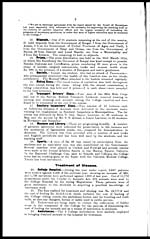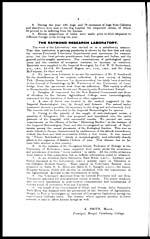Medicine - Veterinary > Civil Veterinary Departments > 1895-1951 - Annual report of the Civil Veterinary Department, Bengal > Annual report of the Bengal Veterinary College and of the Civil Veterinary Department, Bengal, for the year 1913-1914 > Annual report of the Bengal Veterinary College and of the Civil Veterinary Department, Bengal, for the year 1913-1914
(11) Page 3
Download files
Individual page:
Thumbnail gallery: Grid view | List view

3
To remove the sick and injured animals from the streets of Calcutta
and its Suburbs to this hospital, 3 more ambulances have been constructed
which will be located at the Calcutta Corporation Gowkhanas at Alipore,
Circular Road and Mirzapore Street, as soon as sheds are constructed. The
work of removal will be done by the Corporation.
Breeding Operations.
24. The return of stud bulls maintained at this College is included
in Table VIII of the Report of the Civil Veterinary Department, Bengal.
Subordinate Establishment.
25. The total strength of subordinate Veterinary staff employed at this
College is included in Table VII of the Report of the Civil Veterinary
Department, Bengal.
Expenditure of the College.
26. The main results and the receipts and expenditure of the College
are given in Table I.
General Remarks.
27. Mr. A. D. MacGregor of the Indian Civil Veterinary Department
has been posted to this College for training from the 30th March 1914. The
appointment of a second Imperial officer, whose services are indispensably
necessary at this College, is under the consideration of Government.
28. College buildings.— During the year three tanks have been filled
up and certain portions of the College compound have been raised. To the
new Dog Ward have been added a verandah, outhouses and supply of
filtered water.
Two isolation sheds for Rinderpest and Foot and Mouth disease and an
office a dispensary and a godown for the Cattle Ward are under construction
and are expected to be completed shortly.
29. Staff—Have worked with Zeal and ability, giving every satisfaction,
THE EPIZOOTIC DISEASES OF ANIMALS DEPARTMENT,
CALCUTTA.
During the year under report the total number of stables in the Glanders
area under my control was approximately 4,000. all of which wene regularly
inspected. Glanders was detected in 9 stables only.
2. The total number of horses admitted into the Contagious Diseases
(Animal) Hospital at Belgachia was 20, and there was one horse left under
observation at the close of last year. Of these (21), 8 were disposed of for
Glanders under the Act, 2 died of Glanders in hospital, and 11 were dis-
charged as free from Glanders.
3. A sum of Rs. 35 was paid as compensation for horses destroyed
under the Act.
4. Rinderpest was prevalent in Calcutta and its Suburbs from October
1913 to March 1914. Altogether 56 outbreaks of rinderpest were visited
and 1911 head of cattle inoculated with anti-rinderpest serum. Many more
would have been inoculated had the supply of serum not been stopped, owing
to the breakdown of the centrifuge at the Muktesar Laboratory at the time
when rinderpest was very rife. A sum of Rs. 740 was realised on account
of the serum used in Calcutta and Suburbs and credited to Government.
5. While the Remount Depot at Alipore was closed from April to
October, 1,676 horses, 25 cattle and 4 dogs were inspected on board ships in
the Port of Calcutta. No clinical symptom of any infectious disease was
noticed.
6. At the request of the Health Officer of the Corporation of Calcutta,
95 calves—from which vaccine lymph was to be prepared—were tested with
tuberculin at the Animal Vaccine Depôt, Ballygunge. Five cows, one heifer
and one bull-calf were also tested with tuberculin at Mr. I. Harvey's place
at Ballygunge.
7. All the byres in my area, approximately 25,000 in number, were
regularly inspected.
Set display mode to: Large image | Zoom image | Transcription
Images and transcriptions on this page, including medium image downloads, may be used under the Creative Commons Attribution 4.0 International Licence unless otherwise stated. ![]()
| Permanent URL | https://digital.nls.uk/77006427 |
|---|




